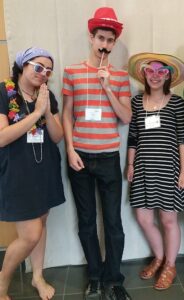How to Shake Up a Church
Adapted from Meg Muckenhoupt and Dan Harper
It is the middle of October and the local Unitarian Universalist (UU) Director of Religious Exploration (DRE) is in a spooky mood! They want to have some fun in the season of remembering our dead. They begin to ponder: should we organise a costume party, or perhaps a fall festival where we can incorporate pumpkin carving, bobbing for apples, and arts & crafts with fallen leaves? They wonder how hard it would be to turn the sanctuary into a haunted house or maze. And then The Idea comes! What about watching a scary movie the weekend before October 31st!?
The movie they pick is Called “How to Shake Up a Church!” What an excellent spooky film to share! The DRE asks the Youth Group to create a small group ministry packet, to prompt conversation after the whole community watches the movie together. They love the idea, and the DRE and youth group spend one of their sessions together watching the film and brainstorming!
The youth observe some disturbing patterns of behaviour in the movie.
- Separation: In the movie, the church gathers the most energetic, creative, socially conscious new members of their community in one big room. They call them the “Tricksters.” They tell them that they’re special, wonderful people. They continue by telling them that they’re so amazing that they have different needs from the rest of the congregation, which would be better filled by meeting with other Tricksters than bothering with the rest of the community.
- Isolation: They arrange for the Tricksters to have their own meetings at times when no one else is in the building. They encourage them to take on new leadership roles and responsibilities, but only in groups made up entirely of Tricksters. They casually mention that non-Trickster committees are “boring” and “don’t get anything done.”
- Disaffection: They lead small-group worship services where each Trickster gets to talk about their own problems, but isn’t required to respond to what anyone else has to say. They say: the Tricksters will get used to concentrating on themselves instead of learning how to listen and worship as part of a congregation. If a few of the Tricksters sneak off and attend the regular Sunday-morning service, they’ll complain that the service is “boring” and “doesn’t speak to me,” and leave.
- Rejection: After the Tricksters have been meeting for a few years, the church tells them that they can no longer use the space. They do not invite them to new UU classes. They say: “ let them find their own heartbroken way back – they will if they’re really UU, after all.”
At the end of the movie the Youth Group feels despondent and frustrated. They know what it’s like to be considered “The Tricksters.” They feel like some of these tactics have been used for their own faith development. They recognize that youth are given special privileges, and not necessarily integrated into our adult community. So they spend a lot of time trying to figure out how to have meaningful conversation about the behaviours they observed in the film. This is what they came up with:
Four Ways to Help a Community Grow!
- Reaching out: Make sure youth are not separated from you and the congregation. Know all the youth in your congregation by name. Introduce youth to those younger and older than themselves. Minister to youth, allow yourself to be ministered to by youth, and get the congregation and the staff to do the same. Offer them an age-appropriate class like New Member Classes (many Coming of Age programs fill this role). Afterwards, invite them to sign the membership book, and explain to them the benefits and responsibilities of membership. Also, be explicit about the privilege and responsibilities of membership (does your congregation have explicit responsibilities and privileges?). Recognize all new members, including youth, during a Sunday morning worship service.
- Integration: Integrate youth into the wider life of the congregation. You cannot rely on one youth advisor (especially one who is not a member of your congregation) to do this. If you have four members of your congregation act as youth advisors, it’s easier on the advisors (and much, much easier to recruit them), and gives the youth four times as many adult contacts. But you need to go beyond that. Invite the youth. Ask if the youth want to help plan worship services – maybe someone would be excited to participate in the worship committee. Or invite them to participate in Social Justice initiatives. Youth can help elders access social media and elders can help youth write letters to their MPs. Explain to youth how to negotiate church politics, and how they can share power with adults. Maybe ask a youth to participate in the Search Committee, and have them help with the process of picking a new minister.
- Growth of affection: When youth and adults work together, play together, and worship together, you find that they begin to make friends with each other. Needless to say, both youth and adults value these friendships. When there is more affection between individuals you’ll find that more and more ministry is being done together, and with each other. If there is a depth of relationship present among the youth and adults within your community, it is more likely that the youth will continue to find space in their busy lives for that connection, because it is something they are benefiting from, and the practice of participating in a beloved community is a benefit to all of us.
- Moving on and staying in touch: Youth grow up. When they grow up, they might leave the community, or they might stick around. But we can help them stay in touch with Unitarian Universalism. When they are still youth, get them to continental events like CanUUdle, or regional events like youth cons, so they get a sense of the wider UU movement. If they stick around, treat them just like the other adults in the community, inviting them to worship, activities and events. Remind them of their privileges and responsibilities of membership when your general meetings happen. They might move away from their community to attend school, or travel, or work somewhere else, keep them connected, both to your local community, and to the national community. Put them in touch with the CUC Youth and Young Adult Office. And complete the cycle, when a UU young adult from another city comes to your community letting you know they were raised UU, honour that, and recognize it. They are there to be in community with you! Not just other young adults, and young families. Ask them what does belonging look like to you, and then help them figure out how they can belong!
The youth group is so excited to share these ideas, and can’t wait for the weekend event with the rest of the community to watch the film with them at the end of the month! They are really looking forward to having conversations with the adults in their community.
They even proposed a name for this plan. It’s called ‘Beloved Community.’ You know how we can hold on to our youth and young adults…. Now that you know, what are you going to do about it?
***
Call and Response, the Canadian Unitarian Council’s new blog, is a forum for sharing ideas, tools, and resources with people and organizations who want to create a more loving, just, and equitable world.

Rev. Danielle Webber and special guests will explore the characteristics of healthy youth groups in a four-session, online training program this Fall/Winter. Registration closes October 20, 2023. It is limited to 15 people per session (30 total).


